Religion of the blooming plum and sharp sword warriors (part of 2)
Huddled together on a muddy road
What a cold!
(Mute)
In the past, the material on the religious beliefs of the samurai, we stopped at the fact that Zen Buddhism was very beneficial to the top of the samurai class. And it is interesting that the matter touched not only the spiritual sphere, but also the practical side of their military and sports preparation for war. The fact is that both in fencing, and in archery, and in various kinds of wrestling without weaponsand even in swimming, the Japanese took the main role not on the physical state, but on the spiritual one. Psychological balance and self-control, developed by Zen, were very important for the samurai. Well, the main way to know the truth in Zen was meditation (zazen) - mindless contemplation of the surroundings in a sitting position and with crossed legs. The place for it was a garden or an empty room, in which there would be nothing to distract the meditator.
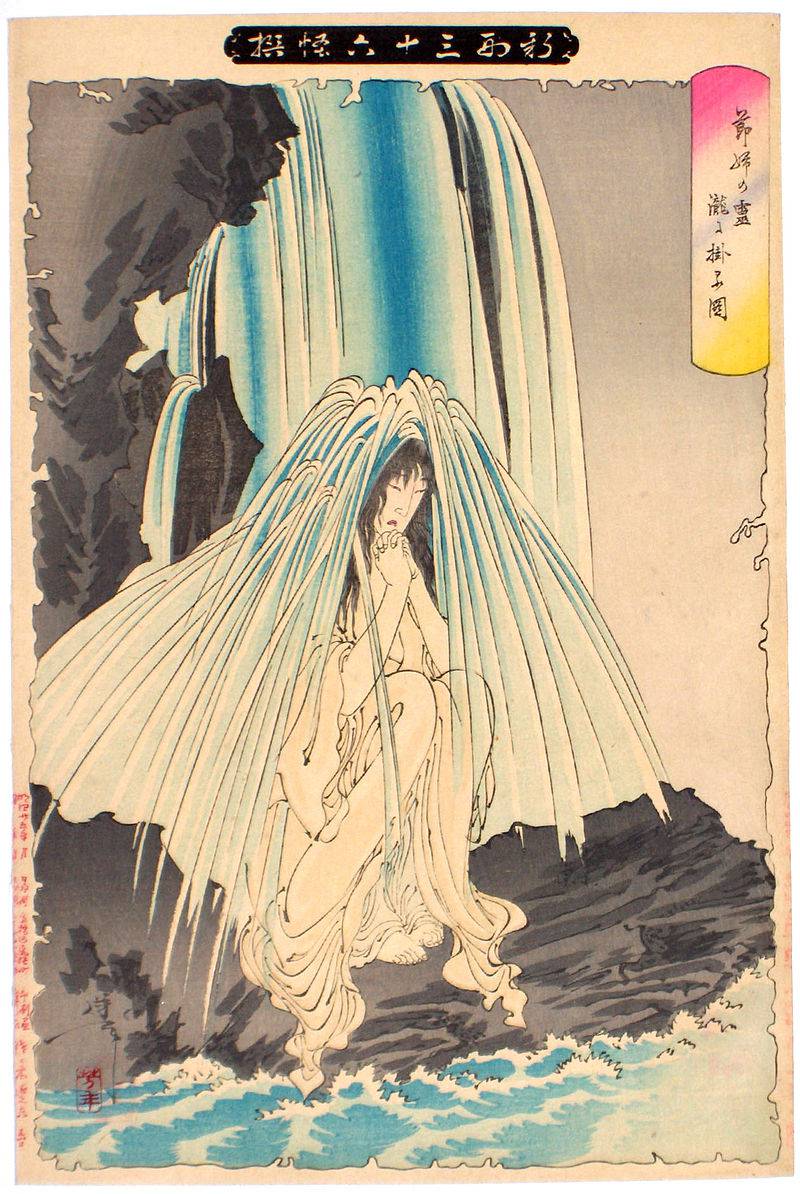
Yoshitoshi Tsukioka (1839 - 1892) - an outstanding Japanese artist who worked in the technique of woodcuts, depicted not only "100 views of the moon." They also performed other series in the uki-e genre, which were as skillfully executed as they were filled with deep meaning. For example, he painted demons, which, as all the Japanese knew well, surrounded them from all sides. Here is one of his works, which is called “The Spirit of the Falls”.
The main rule when contemplating was to train the lungs, the training of a person to take a breathing helped his “self-deepening” and brought up his endurance and patience. The condition that was achieved by this practice was called “musin”, after which it was already possible to reach the moog (or the absence of “me”). That is, a person has renounced all earthly things and, as it were, soars above his mortal body. In such self-deepening, in the opinion of adherents of the school of Zen-soto, a satori - a state of enlightenment - could have per person
A koan or a question that the tutor asked his student was also used. This method was used, for example, by the Rinzai school. Questions mentor should also lead to satori. Moreover, logic was not welcomed here, since the ideal was complete “thoughtlessness” and, again, detachment from earthly existence.
Sometimes, in order to reach satori, the sensei mentor (which is now often practiced in various fashionable sects!) Used the blow of a stick, could suddenly push a person into the dirt and even pinch his nose. All this, however, had a definite purpose - to maintain calm and self-control. Moreover, it was argued that the person who experienced satori looked at life completely differently after that, but the main thing was that such a person could act effectively in any situation, because he remained calm when they pinched his nose and beat him with a stick ...
And it turned out that power, fame, money, and even victory, that is, - all that the Japanese warrior was supposed to strive for, after satori, became of little value to him, which was beneficial for the elite of society, as it allowed saving material benefits on ... rewards! It’s like an order for courage: you got a cheap tsatsku and rejoice ... everyone seems to respect you, although in fact people respect land and expensive cars much more. But any elite usually keeps these benefits for itself!
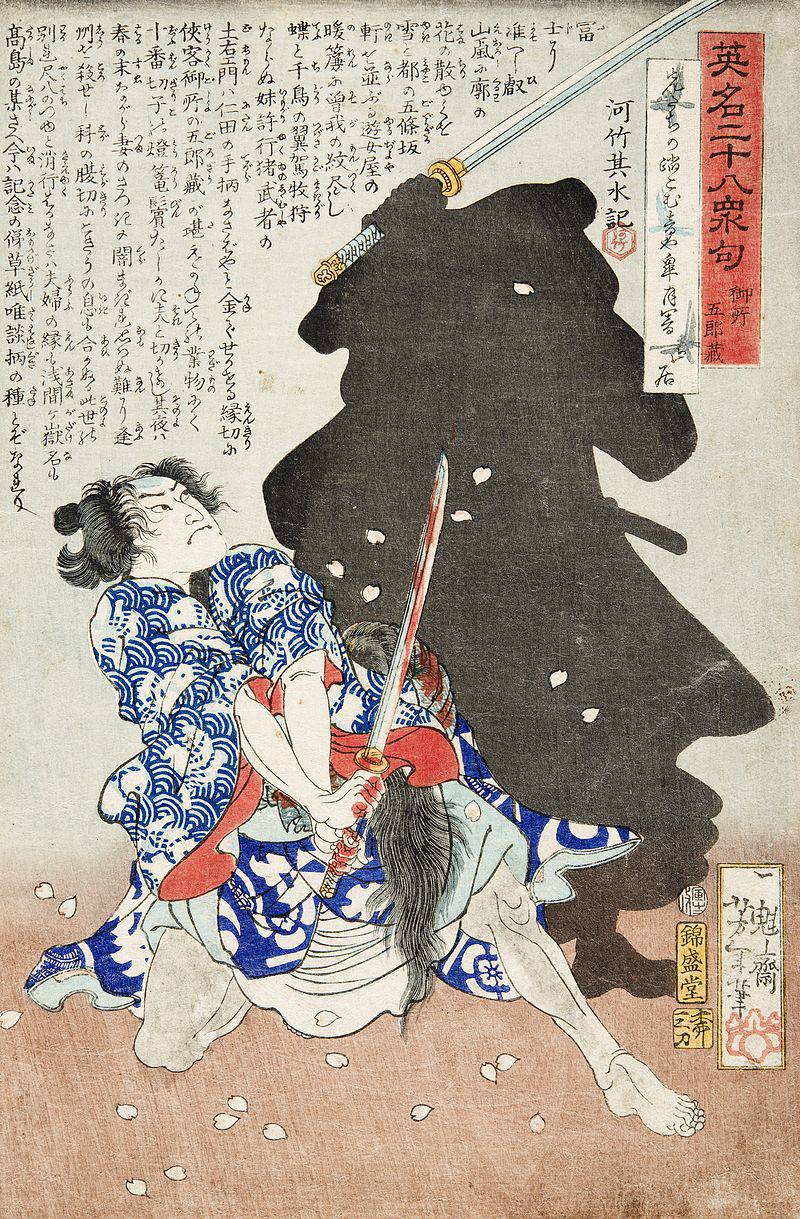
But this is a duel with a shadow and ... who can say that without Sigmund Freud there wasn’t enough?
In the XII - XVI centuries. “Zenxu” entered its highest flowering stage and became a very influential sect in Japan, and was supported by the shogun government. Although we note that Zen Buddhism greatly influenced all areas of Japanese culture. Moreover, the victory of the Tokugawa clan and the assertion in the country of the samurai authorities in some way changed the essence of Zen.
Now Zen was no longer so strict a teaching as it was at the beginning. Of course, readiness at any moment, on the orders of the overlord “to go into emptiness,” has not been canceled. But now the opinion that a person should live and enjoy life, love and appreciate all that is beautiful, has also become established. It was believed that the Japanese warrior should possess not only one military prowess (bu), but also culture, and even humanity (bun).
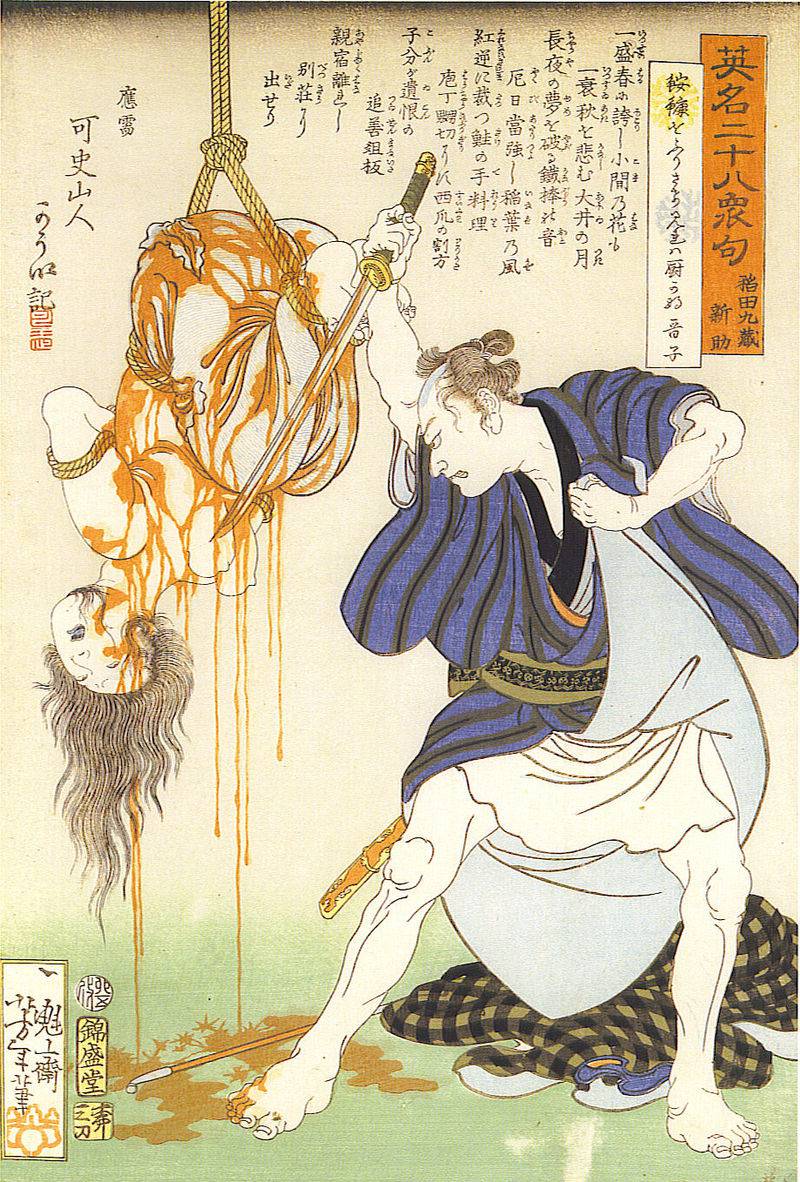
One of the Yoshitoshi xylography series was called “28 Famous Killers”. And why not glorify them? These are not some ordinary murderers, but the most famous !!!
Since the wars in Japan stopped, the samurai began to indulge in the tea ceremony, learned to paint with ink, learned the art of ikebana, and even ... participated in theatrical performances! And here again, the paradox of any religion like “you will not sin, you will not repent”: Zen asserted the uselessness of knowledge, however, the moments of Zen that helped in bringing up the character of a warrior were considered useful and for that… they learned! For example, they were taught by the tea ceremony, because they saw elements of meditation in it and ... why can we drink tea only in Buddhist monasteries and clergy ?! According to legend, the founder of the “Zen” sect of Daruma just fell asleep during meditation, as he was very tired. When he woke up, in a rage he cut off his eyelids for himself, so that they no longer prevented him from following the “path” to “enlightenment”. He threw them on the ground, where they turned into shoots of tea bushes, which gave people a remedy for sleep.
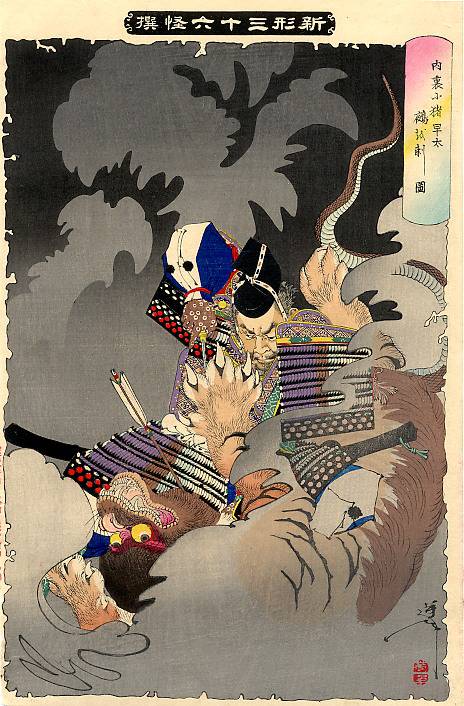
"Killing niu." This is such a mythical creature and why not samurai kill him ?!
So that no fuss of the outside world would prevent quiet contemplation and quiet conversation during a pull, tea houses (tatsitsy) and reception rooms for waiting for this ceremony (yoritsuki) were arranged away from the living quarters, usually somewhere in the depths of the garden. Accordingly, appropriate parks were needed, which contributed to the development of park culture, gardens (gardening) and interior design. Under Oda Nobunaga and Toyotomi Hideyoshi, even special rules of tea etiquette were introduced, compiled by Sanno Rikyu, whom Hideyoshi appointed as the master of the tea ceremony of his palace. The son of a seedy peasant (or woodcutter - opinions diverge here), he sought the nobility of manners to prove to the old aristocracy that he was no worse. Moreover, when Sanno Rikyu fell into disgrace at the age of 71, he did not wait for the old man to die, but ordered him to do seppuku.
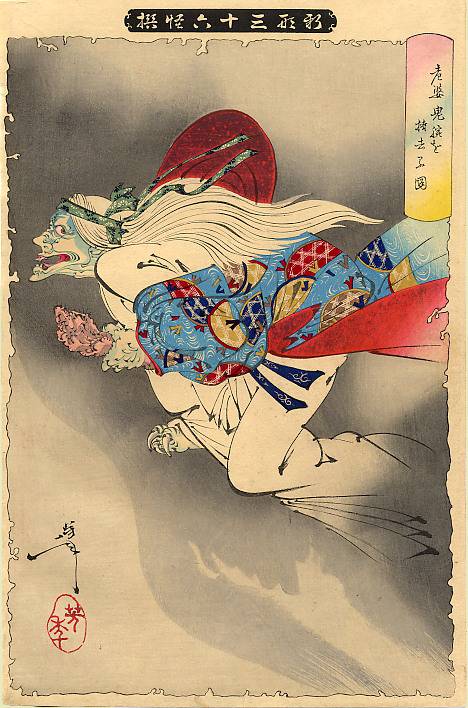
And this is just "Demon". Remember? “The sad Demon, the spirit of exile, flew over the sinful land ...” Here in Yoshitoshi also, but in Japanese!
Dry gardens, which were also initially established only by Zen monks in their monasteries. Well, the Japanese called them “gardens of meditation and thinking” (as an example of such a garden, the garden in Ryoandzi monastery in Kyoto is usually given) also went beyond the monastery walls and began to settle in the courtyards of the nobility, and even ordinary samurai, who took the example of their own overlords.
In the XIV century. Zen teachings also touched the “No” theater - the theatrical art of the highest aristocracy and the serving nobility, which developed from the farcical dance of the sarukagu (which Buddhist priests turned from a comic into a religious dance). It is clear that the plays “But” glorified, first of all, the courage of the ancient heroes (the modern ones were all in sight and could not serve as role models by definition!), And, of course, the faithfulness of the vassal to his master. They were divided into historical (they were also called “military performances” (shura-no) and lyrical (“feminine” (jo-no). Again Hideyoshi himself played in the performances of the No theater, performing on stage with chants and pantomime dances At the same time, his courtiers, rank-and-file feudal lords, and ordinary warriors (in extras) should have participated in the No dance, which was seen as a sign of good form and “fulfillment of a vassal duty.” Nobody dared to refuse, as it would be its violation with all the consequences that follow from this. It’s not without reason that it is noted that one who has gone “from rags to riches” (it doesn’t matter, in Japan or elsewhere) always wants to become “holier than all saints” and tries to succeed everywhere and in Or show that he succeeds everywhere and in everything and for some reason at the same time draws many on the stage ...
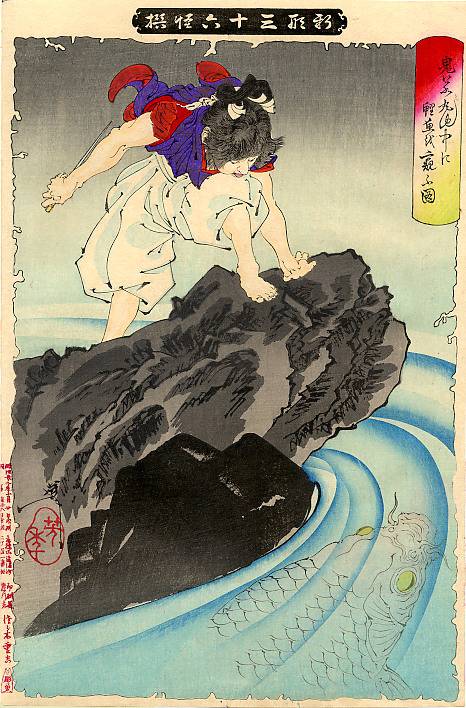
"Big carp". Have you seen such a big carp? So, it’s not just a carp, but a spirit or a demon, so you won’t immediately determine ...
But here the development of military affairs again came into conflict with the culture of Zen. It turned out that no matter how much you contemplate, a musket's bullet will kill you anyway, and you will not even see it and will not be able to dodge as if from an arrow! In addition, peace has come to Japan. The samurai got much more time for their education, and many for various reasons became teachers, poets, artists.
At the same time, other sects began to spread, responding to the "spirit of the times." First of all, it is the “Nitiren” sect, which arose as early as the middle of the 13th century and promised that in a certain time period all beings and things would turn into Buddha, since he is in everything around us. Over time, many samurai became members of the Nitiren sect, but most of the Nitiren were still Ronin, peasants and other sectors of samurai society deprived of the benefits.
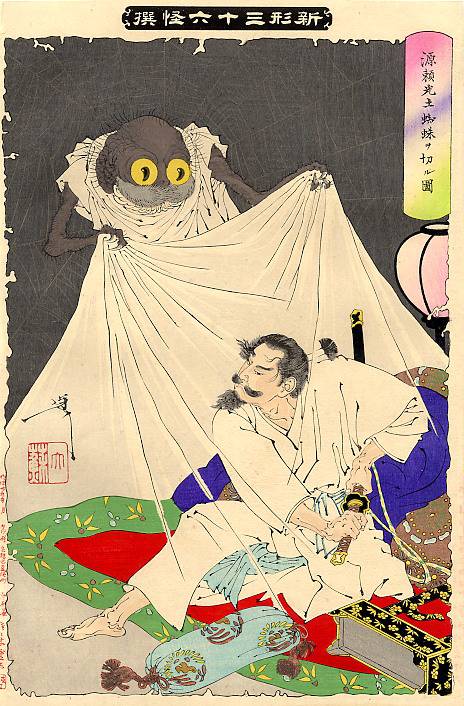
What if such a ghost appears to you in a dream? This is not a Bondarchuk film, is it? Saves only a sharp samurai sword!
The samurai also honored individual deities from the Buddhist pantheon. These included the bodhisattvas Kannon (Avalokitesvara) - the goddess of mercy and compassion and Marisitan (Marici) - a deity who patronized the warriors. Before the march the samurai put small images of Kannon into their helmets; and from Marisiten they asked for protection and help before the start of a fight or battle.
Almost as important in the religion of the samurai was a very ancient cult of Shinto, which quite peacefully got on with Buddhism. The essence of Shinto is the belief in the spirits of nature. That is, in fact, one of the options for paganism. The three main Shinto shrines were considered (and are still viewed today!) By the Japanese as symbols of state power. This is a sacred sword, a jewel (necklace of jade, jasper or just a gem) and a mirror.
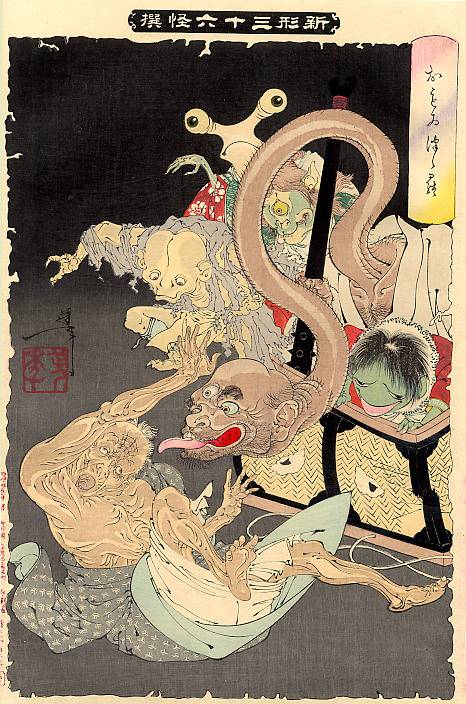
Now you understand, where do Japanese animal painters get ideas for their horror films? Here are the works of the "classics of the genre" still a century ago! By the way, the picture is called “Heavy basket”.
- The sword (ame-no murakumo-no-tsurugi - "The sword of swirling clouds") was a symbol of the whole samurai army, and had to protect Japan from enemies.
- The jewel (yasakani-no magatama, “Shining Curved Jasper”) symbolized perfection, kindness, mercy and at the same time firmness in management. The ancient warriors specially wore a whole bunch of such magatam. It is possible that they (originally the teeth of wild animals) served as amulets, like many other peoples of Siberia.
- The mirror (yat-but kagami - just a “mirror” and that's it!) Was an emblem of wisdom and a symbol of the sun goddess Amaterasu. It has also been used as a protective talisman. Therefore, it was attached between the horns of the Kuwagat helmet.
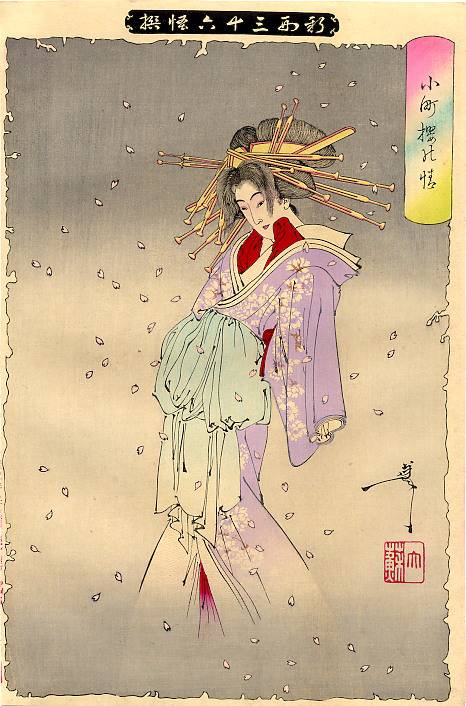
And this is the “Cami of the cherry tree”. And remember: "Cheri, Cheri Lady"? This is the song of the German disco band Modern Talking. And we also have “Cherry, Cherry, Winter Cherry ...” The Japanese understand both of these songs very well. Probably, we all came out of the same Hyperborea ...
All these three attributes of Shinto were often offered to deities as a sacrifice, and sometimes they themselves represented a syntai or “body” of a deity, something like our Christian Trinity.
The ending should ...
Information